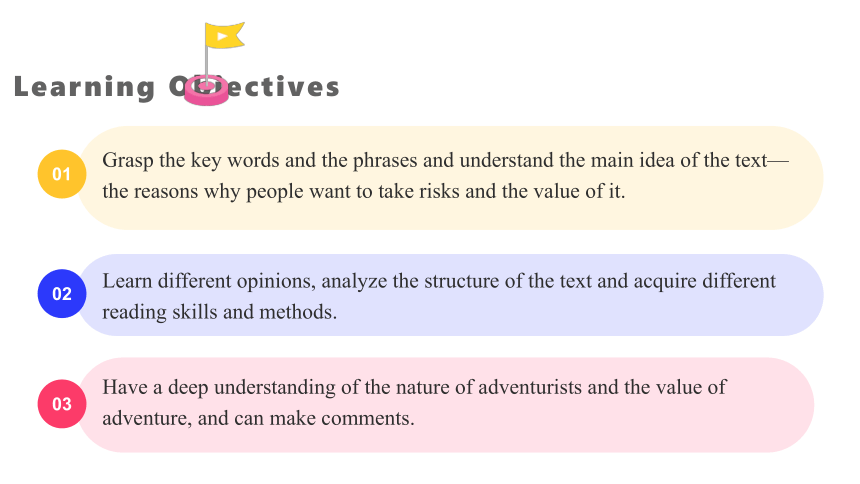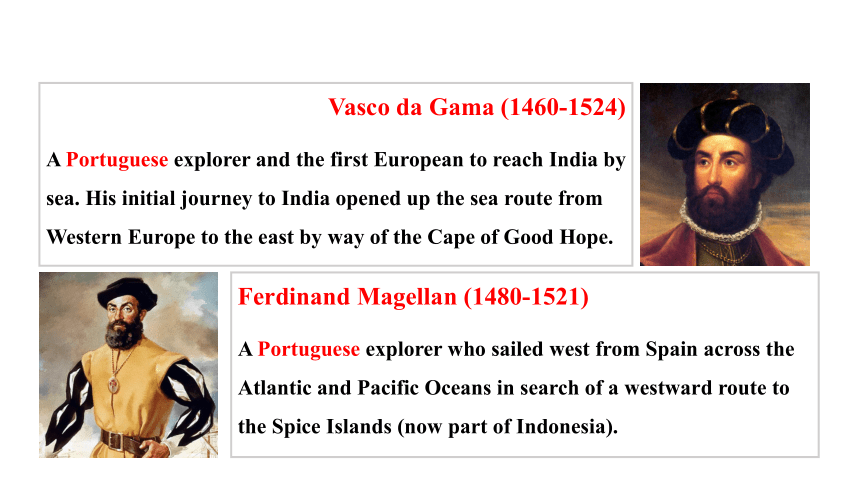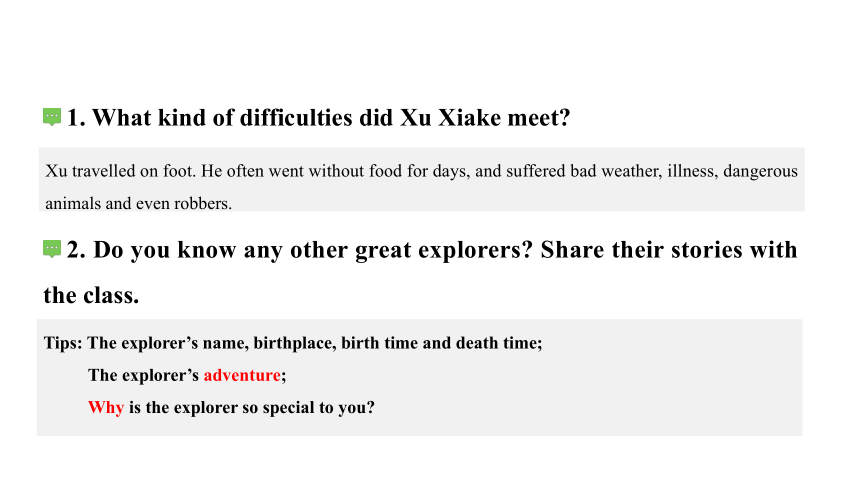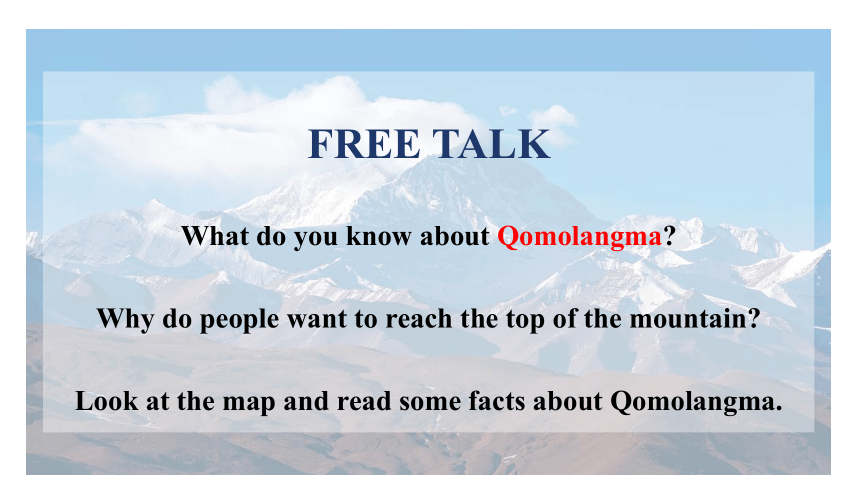Unit 5 What an adventure!Understanding ideas课件(共39张,内嵌视频)-高中英语外研版(2019)必修第三册
文档属性
| 名称 | Unit 5 What an adventure!Understanding ideas课件(共39张,内嵌视频)-高中英语外研版(2019)必修第三册 |  | |
| 格式 | pptx | ||
| 文件大小 | 50.0MB | ||
| 资源类型 | 教案 | ||
| 版本资源 | 外研版(2019) | ||
| 科目 | 英语 | ||
| 更新时间 | 2025-04-03 22:16:33 | ||
图片预览












文档简介
(共39张PPT)
Unit 5
What an adventure!
Learning Objectives
01
Learning Objectives
01
Grasp the key words and the phrases and understand the main idea of the text—the reasons why people want to take risks and the value of it.
03
Have a deep understanding of the nature of adventurists and the value of adventure, and can make comments.
02
Learn different opinions, analyze the structure of the text and acquire different reading skills and methods.
Through reading, students can know the background knowledge of Mount Everest, understand the purpose of writing the article and extract the main information; through thinking and integrating the information, they can summarise the reasons why the climbers climbed the mountain.
Creatively express the benefits and risks of climbing Mount Everest; they can critically and dialectically understand the significance of the Chinese climbers' ascent of Mount Everest and think deeply about their spirit.
01
02
Teaching Focuses and Anticipated Difficulties
What do you know about Qomolangma
Vasco da Gama (1460-1524)
A Portuguese explorer and the first European to reach India by sea. His initial journey to India opened up the sea route from Western Europe to the east by way of the Cape of Good Hope.
Ferdinand Magellan (1480-1521)
A Portuguese explorer who sailed west from Spain across the Atlantic and Pacific Oceans in search of a westward route to the Spice Islands (now part of Indonesia).
Christopher Columbus (1451-1506)
He was an Italian explorer who completed journeys between Spain and the Americas, thus marking the beginning of European exploration of the Americas.
Zheng He (1371-1433)
The first voyage started in Yongle three years (1405), and the last voyage ended in Xuande eight years (1433), totaling seven times. Zheng He's voyage to the west is the largest and longest sailing voyage in China in ancient times.
1. What kind of difficulties did Xu Xiake meet
Xu travelled on foot. He often went without food for days, and suffered bad weather, illness, dangerous animals and even robbers.
2. Do you know any other great explorers Share their stories with the class.
Tips: The explorer’s name, birthplace, birth time and death time;
The explorer’s adventure;
Why is the explorer so special to you
FREE TALK
What do you know about Qomolangma
Why do people want to reach the top of the mountain
Look at the map and read some facts about Qomolangma.
b
a
c
Ferdinand Magellan
Christopher Columbus
Vasco da Gama
Look at the map and match the routes to the explorers.
Look at the map and answer the questions.
Who were the first people confirmed to have reached the top of the mountain When did this happen
Why do you think the climbers need so many camps along the route
What else do you know about Qomolangma Share the information with the class.
Edmund Hillary and Tenzing Norgay.
In 1953.
lt is such a long way that it cannot be done within one day. The climbers need these camps for a rest and adapt themselves to the envronment.
What else do you know about Qomolangma
How high is the Qomolangma
How many camps are there along the route
What problems do you think the climber will face
What does the death zone mean
8,844m
five
exhausted, lack of oxygen, low temperature
Many people died there.
Activity 1
Read the passage and find out what “Type T” personalities are.
"Type T" personalities, with the "T" standing for"thrill", are personality traits that make peoplemore likely to take risks than others.
Talk about your understanding of “Type T” personalities.
Vocabulary
02
1. confirm
confirmation
confirm that/wh-从句
It is/has been confirmed that...
练习:
已证实那个传闻属实。
_________________________ the rumour is true.
It has been confirmed that
n. 证实,确认书,证明书
证实......
据/已证实......
2. succeed
succeed in (doing) sth.
succeed sb. (as...)
succeed to sth.
练习:在他继承了父亲的公司并成为总裁之后,他使公司获得了更大的成功,反过来,这也使他成了一位成功人士。
After ____________ his father's company as president, he _________ in making the company more __________, which helped to make him a ________ in turn.
succeeding
成功做某事
接替某人(担任...…)
继承某物
succeeded
successful
success
3. bring...into focus
focus (one's energy/attention)on...
focus one's eyes on...
the focus of attention
练习:
这场交通事故使行人的安全成为人们关注的焦点。
The accident ________ the pedestrian safety ____________.
brought
集中(某人的精力/注意力)于……
注视…
关注的焦点
into focus
4. attempt
in an attempt to do sth.
attempt to do sth.
at the/one's first attempt
make an attempt to do sth.
make an attempt at doing sth.
练习:他们封闭了道路,试图减少城里的交通流量。
They closed the road ___________________ reduce traffic in the city.
in an attempt to
为了做某事
努力/试图做某事
第一次尝试
尝试做某事
尝试做某事
5. result in
result from...
as a result of...
as a result
without result
练习:做事不先考虑常会导致失败。
Acting before thinking often ______________ failure.
results in
由…...造成(后接原因)
由于
结果
徒劳;毫无结果
Read the text and match the main idea of theparagraphs.
A. The scientifie reasons behind taking risks.
B. The way to measure the risks we take.
C. The common situation of climbing Oomolangma.
D.The famous examples and comments about climbing.
Paragraph 1
Paragraph 2-3
Paragraph 4-6
Paragraph 7
Read the passage again.
Choose the best answer accordingto the text.
1. What do we know about mountain climbing from Paragraph 1
A. There were few people climbing Qomolangma.
B. Most people lost their lives while climbing.
C.Climbing Qomolangma makes a man powerful.
D. Many people planned to return before the end of the trip.
Read the passage again.
Choose the best answer accordingto the text.
2. What do George Mallory and Alan Arnette have in common
A. They both succeeded in climbing Qomolangma.
B. They both climbed many other high mountains afterwards.
C. They both found the risks of climbing worth taking.
D. They both found the real meaning of life and enioyed it.
Read the passage again.
Choose the best answer accordingto the text.
3. Who is likely to be called a man with “Type T, personalities
A. A passenger on the plane.
B. A lady driving cars on the road.
C. An old man making money to live.
D. A young man climbing the Qomolangma.
Read the passage again.
Choose the best answer accordingto the text.
4. How can we measure the action ofclimbing Qomolangma
A. By taking more risks and climbing more.
B. By balancing the benefits and the result.
C. By being an expert and expecting not to die.
D. By equipping yourself with “Type T”
Introducing the topic
Reasons
for the climbers
risk-taking
Para. 1: Climbing Qomolangma is a special experience.
Conclusion
Para. 2: George Mallory: just pure joy; enjoy life
Para. 6: man's desire to expect to benefit from the result
Para. 3: Alan Arnette: lt forces people to look inside themselves and figure out if they really have the physical and mental toughness.
Para. 4-5: perhaps part of human nature: “Type T" personalities
Para. 7: lt's up to the readers to decide whether it is worth the risks to climb Qomolangma.
Subjective
reasons
Scientific
reasons
Activity 3
Choose the author’s purpose in writing the passage.
1 To encourage people to climb Qomolangma if fully prepared, as risks bring many benefits.
2 To remind people to balance the benefits and risks before deciding to climb Qomolangma.
3 To suggest that people stop taking risks and climbing Qomolangma, as the risks outweigh
the benefits.
Activity 4
Complete the paragraphs with the expressions from the passage.
Why Do People Climb Qomolangma
George Mallory
What people get from this adventure is just __________. People eat and make money to be able to _________, not the other way round.
sheer joy
enjoy life
Activity 4
Complete the paragraphs with the expressions from the passage.
Why Do People Climb Qomolangma
Alan Arnette
Each person has a (n) __________________ reason for climbing a mountain. It forces people to __________________ themselves. To succeed, people must have the physical as well as __________________.
important and unique
look deep inside
mental toughness
Activity 4
Complete the paragraphs with the expressions from the passage.
Scientific reasons
Risk-taking may be part of _______________. People who are more likely to ________________ have “Type T” personalities. Research also suggests that our desire to seek risks can be connected to how much we expect to ___________________.
human nature
take risks
benefit from the result
1. Do you agree with Mallory’s and Arnette’s opinions Why
2. If you were given the chance, would you like to climb Qomolangma
Why or why not
Think & Share
Yes, I do.
We need a little spirit of adventure in life.
He refers to the personalities of these people as ”Type T”, with the “T” standing for “thrill”.
refer to...as..
refer to...as... 意为"把……称作……"。
The Chinese refer to their language as Han, as it became popular among the Han Dynasty.
中国人把他们的语言称为"汉"语,因为它在汉朝的时候开始流行起来。
It is still not known if he succeeded in reaching the top of Qomolangma before it took his life.
if 引导的主语从句
if 引导的主语从句不能位于句首,只能位于句末,前面需用作形式主语。在从句中不充当句子成分,仅起连接作用,意为"是否"。
He hasn't been decided if we'll go for an autumn outing.
我们是否要去秋游还没定下来。
Summary
03
教学实施方案
Homework
04
Homework
1. summarise what we have learnt in this lesson;
2. prepare for the next lesson
See you
next class!
Unit 5
What an adventure!
Learning Objectives
01
Learning Objectives
01
Grasp the key words and the phrases and understand the main idea of the text—the reasons why people want to take risks and the value of it.
03
Have a deep understanding of the nature of adventurists and the value of adventure, and can make comments.
02
Learn different opinions, analyze the structure of the text and acquire different reading skills and methods.
Through reading, students can know the background knowledge of Mount Everest, understand the purpose of writing the article and extract the main information; through thinking and integrating the information, they can summarise the reasons why the climbers climbed the mountain.
Creatively express the benefits and risks of climbing Mount Everest; they can critically and dialectically understand the significance of the Chinese climbers' ascent of Mount Everest and think deeply about their spirit.
01
02
Teaching Focuses and Anticipated Difficulties
What do you know about Qomolangma
Vasco da Gama (1460-1524)
A Portuguese explorer and the first European to reach India by sea. His initial journey to India opened up the sea route from Western Europe to the east by way of the Cape of Good Hope.
Ferdinand Magellan (1480-1521)
A Portuguese explorer who sailed west from Spain across the Atlantic and Pacific Oceans in search of a westward route to the Spice Islands (now part of Indonesia).
Christopher Columbus (1451-1506)
He was an Italian explorer who completed journeys between Spain and the Americas, thus marking the beginning of European exploration of the Americas.
Zheng He (1371-1433)
The first voyage started in Yongle three years (1405), and the last voyage ended in Xuande eight years (1433), totaling seven times. Zheng He's voyage to the west is the largest and longest sailing voyage in China in ancient times.
1. What kind of difficulties did Xu Xiake meet
Xu travelled on foot. He often went without food for days, and suffered bad weather, illness, dangerous animals and even robbers.
2. Do you know any other great explorers Share their stories with the class.
Tips: The explorer’s name, birthplace, birth time and death time;
The explorer’s adventure;
Why is the explorer so special to you
FREE TALK
What do you know about Qomolangma
Why do people want to reach the top of the mountain
Look at the map and read some facts about Qomolangma.
b
a
c
Ferdinand Magellan
Christopher Columbus
Vasco da Gama
Look at the map and match the routes to the explorers.
Look at the map and answer the questions.
Who were the first people confirmed to have reached the top of the mountain When did this happen
Why do you think the climbers need so many camps along the route
What else do you know about Qomolangma Share the information with the class.
Edmund Hillary and Tenzing Norgay.
In 1953.
lt is such a long way that it cannot be done within one day. The climbers need these camps for a rest and adapt themselves to the envronment.
What else do you know about Qomolangma
How high is the Qomolangma
How many camps are there along the route
What problems do you think the climber will face
What does the death zone mean
8,844m
five
exhausted, lack of oxygen, low temperature
Many people died there.
Activity 1
Read the passage and find out what “Type T” personalities are.
"Type T" personalities, with the "T" standing for"thrill", are personality traits that make peoplemore likely to take risks than others.
Talk about your understanding of “Type T” personalities.
Vocabulary
02
1. confirm
confirmation
confirm that/wh-从句
It is/has been confirmed that...
练习:
已证实那个传闻属实。
_________________________ the rumour is true.
It has been confirmed that
n. 证实,确认书,证明书
证实......
据/已证实......
2. succeed
succeed in (doing) sth.
succeed sb. (as...)
succeed to sth.
练习:在他继承了父亲的公司并成为总裁之后,他使公司获得了更大的成功,反过来,这也使他成了一位成功人士。
After ____________ his father's company as president, he _________ in making the company more __________, which helped to make him a ________ in turn.
succeeding
成功做某事
接替某人(担任...…)
继承某物
succeeded
successful
success
3. bring...into focus
focus (one's energy/attention)on...
focus one's eyes on...
the focus of attention
练习:
这场交通事故使行人的安全成为人们关注的焦点。
The accident ________ the pedestrian safety ____________.
brought
集中(某人的精力/注意力)于……
注视…
关注的焦点
into focus
4. attempt
in an attempt to do sth.
attempt to do sth.
at the/one's first attempt
make an attempt to do sth.
make an attempt at doing sth.
练习:他们封闭了道路,试图减少城里的交通流量。
They closed the road ___________________ reduce traffic in the city.
in an attempt to
为了做某事
努力/试图做某事
第一次尝试
尝试做某事
尝试做某事
5. result in
result from...
as a result of...
as a result
without result
练习:做事不先考虑常会导致失败。
Acting before thinking often ______________ failure.
results in
由…...造成(后接原因)
由于
结果
徒劳;毫无结果
Read the text and match the main idea of theparagraphs.
A. The scientifie reasons behind taking risks.
B. The way to measure the risks we take.
C. The common situation of climbing Oomolangma.
D.The famous examples and comments about climbing.
Paragraph 1
Paragraph 2-3
Paragraph 4-6
Paragraph 7
Read the passage again.
Choose the best answer accordingto the text.
1. What do we know about mountain climbing from Paragraph 1
A. There were few people climbing Qomolangma.
B. Most people lost their lives while climbing.
C.Climbing Qomolangma makes a man powerful.
D. Many people planned to return before the end of the trip.
Read the passage again.
Choose the best answer accordingto the text.
2. What do George Mallory and Alan Arnette have in common
A. They both succeeded in climbing Qomolangma.
B. They both climbed many other high mountains afterwards.
C. They both found the risks of climbing worth taking.
D. They both found the real meaning of life and enioyed it.
Read the passage again.
Choose the best answer accordingto the text.
3. Who is likely to be called a man with “Type T, personalities
A. A passenger on the plane.
B. A lady driving cars on the road.
C. An old man making money to live.
D. A young man climbing the Qomolangma.
Read the passage again.
Choose the best answer accordingto the text.
4. How can we measure the action ofclimbing Qomolangma
A. By taking more risks and climbing more.
B. By balancing the benefits and the result.
C. By being an expert and expecting not to die.
D. By equipping yourself with “Type T”
Introducing the topic
Reasons
for the climbers
risk-taking
Para. 1: Climbing Qomolangma is a special experience.
Conclusion
Para. 2: George Mallory: just pure joy; enjoy life
Para. 6: man's desire to expect to benefit from the result
Para. 3: Alan Arnette: lt forces people to look inside themselves and figure out if they really have the physical and mental toughness.
Para. 4-5: perhaps part of human nature: “Type T" personalities
Para. 7: lt's up to the readers to decide whether it is worth the risks to climb Qomolangma.
Subjective
reasons
Scientific
reasons
Activity 3
Choose the author’s purpose in writing the passage.
1 To encourage people to climb Qomolangma if fully prepared, as risks bring many benefits.
2 To remind people to balance the benefits and risks before deciding to climb Qomolangma.
3 To suggest that people stop taking risks and climbing Qomolangma, as the risks outweigh
the benefits.
Activity 4
Complete the paragraphs with the expressions from the passage.
Why Do People Climb Qomolangma
George Mallory
What people get from this adventure is just __________. People eat and make money to be able to _________, not the other way round.
sheer joy
enjoy life
Activity 4
Complete the paragraphs with the expressions from the passage.
Why Do People Climb Qomolangma
Alan Arnette
Each person has a (n) __________________ reason for climbing a mountain. It forces people to __________________ themselves. To succeed, people must have the physical as well as __________________.
important and unique
look deep inside
mental toughness
Activity 4
Complete the paragraphs with the expressions from the passage.
Scientific reasons
Risk-taking may be part of _______________. People who are more likely to ________________ have “Type T” personalities. Research also suggests that our desire to seek risks can be connected to how much we expect to ___________________.
human nature
take risks
benefit from the result
1. Do you agree with Mallory’s and Arnette’s opinions Why
2. If you were given the chance, would you like to climb Qomolangma
Why or why not
Think & Share
Yes, I do.
We need a little spirit of adventure in life.
He refers to the personalities of these people as ”Type T”, with the “T” standing for “thrill”.
refer to...as..
refer to...as... 意为"把……称作……"。
The Chinese refer to their language as Han, as it became popular among the Han Dynasty.
中国人把他们的语言称为"汉"语,因为它在汉朝的时候开始流行起来。
It is still not known if he succeeded in reaching the top of Qomolangma before it took his life.
if 引导的主语从句
if 引导的主语从句不能位于句首,只能位于句末,前面需用作形式主语。在从句中不充当句子成分,仅起连接作用,意为"是否"。
He hasn't been decided if we'll go for an autumn outing.
我们是否要去秋游还没定下来。
Summary
03
教学实施方案
Homework
04
Homework
1. summarise what we have learnt in this lesson;
2. prepare for the next lesson
See you
next class!
